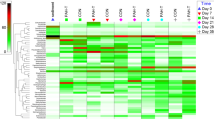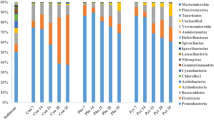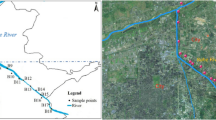Abstract
Mangrove sediment is well known for its susceptibility to anthropogenic pollution, including polycyclic aromatic hydrocarbons (PAHs), but knowledge of the sediment microbial community structure with regards to exposure to PAHs is limited. The study aims to assess the effects of PAHs on the bacterial community of mangrove sediment using both 16s rDNA polymerase chain reaction-denaturing gradient gel electrophoresis (PCR-DGGE) and traditional enrichment methods. Both the exposure time and the PAH concentration reduced the microbial diversity, as determined by the DGGE bands. Although PAHs could act as carbon sources for microorganisms, PAHs, at a concentration as low as 20 mg l−1, posed a toxic effect to the microbial community. Sequencing of DGGE bands showed that marine bacteria from the genera of Vibrio, Roseobacter, and Ferrimonas were most abundant after PAH exposure, which suggests that both marine and terrestrial bacteria coexisted in the mangrove sediment, but that the marine microbes were more difficult to isolate using the traditional culture method. DGGE determination further demonstrated that the consistency among triplicates of the enriched consortia was significantly less than that of the sediment slurries. The present study reveals that the mangrove sediment microbial structure is susceptible to PAH contamination, and complex microbial community interactions occur in mangrove sediment.



Similar content being viewed by others
References
Harvey RG (1997) Polycyclic aromatic hydrocarbons. Wiley-VCH, New York
Pohlman JW, Coffin RB, Mitchell CS, Montgomery MT, Spargo BJ, Steele JK, Boyd TJ (2002) Transport, deposition and biodegradation of particle bound polycyclic aromatic hydrocarbons in a tidal basin of an industrial watershed. Environ Monit Assess 75:155–167
Lei T, Pei M, Zhong JJ (2003) Impact of the presence of salicylate or glucose on enzyme activity and phenanthrene degradation by Pseudomonas mendocina. Proc Biochem 38:1125–1132
Zheng GJ, Man BKM, Lam JCW, Lam MHW, Lam PKS (2002) Distribution and sources of polycyclic aromatic hydrocarbons in the sediment of a sub-tropical coastal wetland. Water Res 36:1457–1468
Holguin G, Vazquez P, Bashan Y (2001) The role of sediment microorganisms in the productivity, conservation, and rehabilitation of mangrove ecosystems: an overview. Biol Fertil Soils 33:265–278
El-Tarabily KA (2002) Total microbial activity and microbial composition of a mangrove sediment are reduced by oil pollution at a site in the Arabian Gulf. Can J Microbiol 48:176–182
Yu SH, Ke L, Wong YS, Tam NFY (2005) Degradation of polycyclic aromatic hydrocarbons by a bacterial consortium enriched from mangrove sediments. Environ Int 31:149–154
Chung WK, King GM (2001) Isolation, characterization, and polyaromatic hydrocarbon degradation potential of aerobic bacteria from marine macrofaunal burrow sediments and description of Lutibacterium anuloederans gen. nov., sp nov., and Cycloclasticus spirillensus sp nov. Appl Environ Microbiol 67:5585–5592
van Herwijnen R, Wattiau P, Bastiaens L, Daal L, Jonker L, Springael D, Govers HAJ, Parsons JR (2003) Elucidation of the metabolic pathway of fluorene and cometabolic pathways of phenanthrene, fluoranthene, anthracene and dibenzothiophene by Sphingomonas sp LB126. Res Microbiol 154:199–206
Guo CL, Zhou HW, Wong YS, Tam NFY (2005) Isolation of PAH-degrading bacteria from mangrove sediments and their biodegradation potential. Marine Pollut Bull 51:1054–1061
Zhou HW, Guo CL, Wong YS, Tam NFY (2006) Genetic diversity of dioxygenase genes in PAH-degrading bacteria isolated from mangrove sediments. FEMS Microbiol Lett 262:148–157
Zhou HW, Luan TG, Zou F, Tam NFY (2008) Different bacterial groups for biodegradation of three- and four-ring PAHs isolated from a Hong Kong mangrove sediment. J Hazard Mater 152:1179–1185
Feris KP, Hristova K, Gebreyesus B, Mackay D, Scow KM (2004) A shallow BTEX and MTBE contaminated aquifer supports a diverse microbial community. Microb Ecol 48:589–600
Chao WL, Hsu SF (2004) Response of the soil bacterial community to the addition of toluene and toluene-degrading bacteria. Soil Biol Biochem 36:479–487
Daane LL, Harjono I, Zylstra GJ, Haggblom MM (2001) Isolation and characterization of polycyclic aromatic hydrocarbon-degrading bacteria associated with the rhizosphere of salt marsh plants. Appl Environ Microbiol 67:2683–2691
Gaskin S, Bentham R (2005) Comparison of enrichment methods for the isolation of pyrene-degrading bacteria. Int Biodeter Biodegrad 56:80–85
Hilyard EJ, Jones-Meehan JM, Spargo BJ, Hill RT (2008) Enrichment, isolation, and phylogenetic identification of polycyclic aromatic hydrocarbon-degrading bacteria from Elizabeth River sediments. Appl Environ Microbiol 74:1176–1182
Dunbar J, White S, Forney L (1997) Genetic diversity through the looking glass: effect of enrichment bias. Appl Environ Microbiol 63:1326–1331
Tam NFY, Ke L, Wang XH, Wong YS (2001) Contamination of polycyclic aromatic hydrocarbons in surface sediments of mangrove swamps. Environ Pollut 114(2):255–263
Ke L, Wong TWY, Wong YS, Tam NFY (2002) Fate of polycyclic aromatic hydrocarbon (PAH) contamination in a mangrove swamp in Hong Kong following an oil spill. Marine Pollut Bull 45:339–347
Bachoon DS, Hodson RE, Araujo R (2001) Microbial community assessment in oil-impacted salt marsh sediment microcosms by traditional and nucleic acid-based indices. J Microbiol Methods 46:37–49
Tabak HH, Lens P, van Hullebusch ED, Dejonghe W (2005) Developments in bioremediation of soils and sediments polluted with metals and radionuclides? Microbial processes and mechanisms affecting bioremediation of metal contamination and influencing metal toxicity and transport. Rev Environ Sci Biotechnol 4:115–156
McKew BA, Coulon F, Osborn AM, Timmis KN, McGenity TJ (2007) Determining the identity and roles of oil-metabolizing marine bacteria from the Thames estuary, UK 2006. Environ Microbiol 9:165–176
Hedlund BP, Staley JT (2001) Vibrio cyclotrophicus sp. nov., a polycyclic aromatic hydrocarbon (PAH)-degrading marine bacterium. Int J Syst Evol Microbiol 51:61–66
Singleton DR, Powell SN, Sangaiah R, Gold A, Ball LM, Aitken MD (2005) Stable-isotope probing of bacteria capable of degrading salicylate, naphthalene, or phenanthrene in a bioreactor treating contaminated soil. Appl Environ Microbiol 71(3):1202–1209
Stach JEM, Burns RG (2002) Enrichment versus biofilm culture: a functional and phylogenetic comparison of polycyclic aromatic hydrocarbon-degrading microbial communities. Environ Microbiol 4:169–182
Johnsen AR, Karlson U (2007) Diffuse PAH contamination of surface soils: environmental occurrence, bioavailability, and microbial degradation. Appl Microbiol Biotechnol 76:533–543
Acknowledgments
The work described in this paper was financially supported by the Research Grants Council of the HKSAR (Project No. RGC reference CityU 1406/06M). The project was also supported by Guangdong Natural Science Foundation (7300224).
Author information
Authors and Affiliations
Corresponding author
Rights and permissions
About this article
Cite this article
Zhou, H.W., Wong, A.H.Y., Yu, R.M.K. et al. Polycyclic Aromatic Hydrocarbon-Induced Structural Shift of Bacterial Communities in Mangrove Sediment. Microb Ecol 58, 153–160 (2009). https://doi.org/10.1007/s00248-008-9456-x
Received:
Accepted:
Published:
Issue Date:
DOI: https://doi.org/10.1007/s00248-008-9456-x




